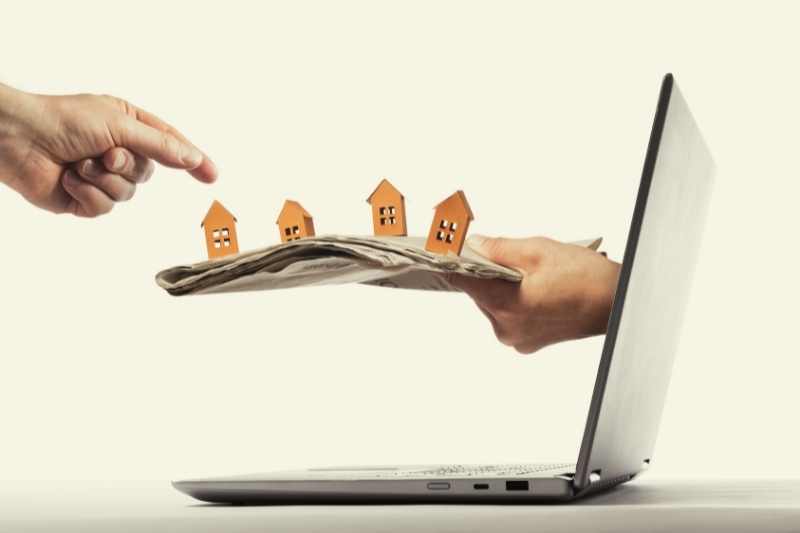Key takeaways:
- In the 2020s, the landscape of proptech is growing exponentially, spurred by both the COVID-19 pandemic and technological innovations.
- Virtual reality, contactless access, AI-driven marketing, and the Internet of Things are the top proptech innovations reshaping the real estate landscape.
- It only takes a few changes to turn a traditional building into a smart one. This year’s top trends in proptech are smart locks, amenity reservation platforms, self-guided tours, smart lighting controls, and smart thermostats.

In the 2020s, technology plays a pinnacle role in every aspect of life — and the real estate industry is no exception! The property technology (proptech) landscape is revolutionizing the industry by introducing new technological innovations that improve our lives and work. As a result, real estate as we know it must change to keep pace. Primarily, this change is seen in an increased demand for modern, digitized proptech amenities.
Also called real estate technology, proptech refers to the products and services that use technology to streamline how people interact with properties. So, proptech is a must-have if you want your property to stand out against competitors.
Read on to learn more about the proptech landscape, including its origins. We also explore how the 2020s have fundamentally changed proptech and real estate. Then, we guide you through adapting to the evolving landscape of the real estate industry.
This guide covers:
- When did proptech emerge as a landscape?
- Proptech’s landscape and the 2020s: What’s changed?
- How can you adapt to the changing landscape of proptech in 2025?
When did the proptech landscape emerge?
Believe it or not, the proptech landscape emerged in the pre-industrial era when the first multifamily buildings were constructed. Even then, property managers and owners looked for new, exciting ways to market their properties, including offering telephones and electric lighting. And those amenities, evolving from private bathrooms to business centers, have long been a reliable way to approach property marketing.
However, as the real estate industry has advanced into a new age, residents now expect perks like pools, community events, and on-site laundry. So, to attract new, young residents, property managers must turn to new real estate innovations.

Fast-forward to the 1990s, when global internet usage skyrocketed and proptech entered the real estate market as an amenity. Proptech’s ability to simplify routine activities for both staff and residents led to rapid growth in the digitization of services.
Nowadays, a boom in new technologies like artificial intelligence drive the current wave of proptech innovation. Additionally, the industry has evolved exponentially as a result of the COVID-19 pandemic increasing demand for contactless services.
Today, selecting proptech to invest in is a necessity, not just a luxury.
Why must property managers rely on proptech?
Technology can improve operations at all types of properties — multifamily, gated communities, student housing, and commercial properties.
Modern property managers rely on proptech to streamline building operations and enhance the resident experience. As such, proptech amenities are no longer the exception, but rather an expectation.
Because of this, real estate professionals must incorporate it into their properties. In fact, doing so is essential in standing out in a sea of expanding proptech innovation.
But wait, there’s more:
At its core, proptech empowers managers to keep operating costs low while increasing tenant retention. This helps maximize a property’s net operating income (NOI), increasing its value. In other words, implementing proptech will save you time, money, and energy while also lowering tenant turnover.

Proptech landscape & the 2020s: What’s changed?
The COVID-19 pandemic has forever changed how we use technology to interact with physical spaces.
And that change is just getting started.
So, now is the time to invest in smart technologies to ensure your property withstands the test of time. Whether implementing best health practices to keep your residents well or turning an average building into a smart one, proptech is here to help.
Let’s look at some of today’s proptech solutions disrupting the industry for the better.
The top four proptech innovations that are changing real estate:
1. Virtual reality
Goldman Sachs reports that, by 2025, approximately 1.4 million real estate professionals will rely upon virtual reality. And virtual reality falls within the proptech landscape primarily through virtual tours.
Many companies have shifted to a fully remote work environment in the aftermath of the pandemic. Many workers have taken advantage of this new circumstance by relocating — sometimes nationwide! Many city dwellers are heading for the suburbs and rural areas.
As a result, more renters than ever rely on virtual tours when choosing their next homes. And keep in mind: As more properties offer virtual touring options, renters will come to expect them. So, keep up with this growing demand by investing time and resources into offering robust virtual tours today!
Watch our complete guide to virtual staging software:
2. Contactless access
The pandemic fundamentally changed the physical aspects of the real estate industry. Namely, it necessitated social distancing practices, causing a shift from high-touch to high-tech property access.
With contactless property access, tenants, staff, and visitors open doors and gates by tapping on their smartphones. As a result, you and your staff will save time while streamlining and simplifying your residents’ daily routines.
3. AI-driven marketing
Artificial intelligence (AI) is a must-have for modern property management. From auto-generating emails to installing chatbots on your website, AI will drive the next stage in real estate marketing.
Now more than ever, residents are signing leases sight-unseen. So, instead of making a good impression in person, you can use proptech to make a good impression virtually! Implementing AI-driven marketing will automate your marketing efforts and make finding good tenants easier.
You must fulfill their tech cravings since millennials and younger generations now make up most of the renter pool. And you can make a great first impression by using cutting-edge AI marketing tools in the prospecting process.
4. Internet of Things
The Internet of Things (IoT) refers to the network of smart devices that communicate with other internet-powered technology. Typically, they share data through the cloud. For example, in an IoT-enabled property, you can monitor maintenance, security, and temperature from anywhere via a mobile device through one central hub.
If you want to create a well-rounded tenant experience, incorporating the Internet of Things is a must. Ensure your proptech devices can communicate with each other by enabling integrations. In well-integrated smart buildings, tenants move through the property seamlessly, controlling multiple processes with their smartphones.
To go one step further, install sensor technology, such as smart lights, so that the devices activate only when someone enters the room.
How can you adapt to the changing landscape of proptech in 2025?
Data doesn’t lie. And all proptech data points to a direct link between optimal tech integrations and a positive resident experience.
However, you may hesitate to implement new real estate technology at your property. This might be especially true if your current systems are running smoothly and you’ve grown accustomed to them.
Because the modern world is so digitized, a high-tech living experience is no longer an amenity. Instead, it’s now a necessity that renters expect. And keeping up with the latest proptech trends is the best way to stay ahead of the game.
Pro tip: Implementing new proptech solutions at your property doesn’t have to mean flipping your entire property upside down. Instead, turning your traditional building into a smart one can entail simply swapping a handful of your current systems for proptech options!
Discover the top 5 technology trends to watch:
Here are the top proptech innovations to add to your property:
- Smart locks are electromechanical lock systems powered by smartphones. They’re locked and unlocked remotely using an app.
- Amenity reservation platforms make reserving amenity spaces easy for you and your tenants. A facet of property management software, amenity reservation platforms can be in-app or online and automatically assign access permissions to tenants once your staff approves the requests.
- Self-guided tours are key in the current and future real estate market because prospects want to tour properties conveniently. So, offer self-guided tours powered by tech that allow prospects to view a property on their own. This also frees up time for your leasing agent, who won’t have to lead tours all day but instead can spend more time developing relationships with prospects.
- Smart lighting controls are a small convenience that can be a big help for your residents, allowing them to switch lights on or off remotely. For example, a resident can turn lights on for pets even if they’re out later than expected. Conversely, they can turn off lights they accidentally left on to keep energy bills low.
- Smart thermostats. Speaking of lowering bills, smart thermostats don’t just allow users to adjust the temperature from their smartphones. They can also detect when residents aren’t home and automatically turn off heating and cooling functions, further saving on electricity bills.
The proptech landscape is growing so quickly that real estate professionals must be proactive to keep up. But by implementing the top trends in proptech, you can future-proof your property and beat the competition.






